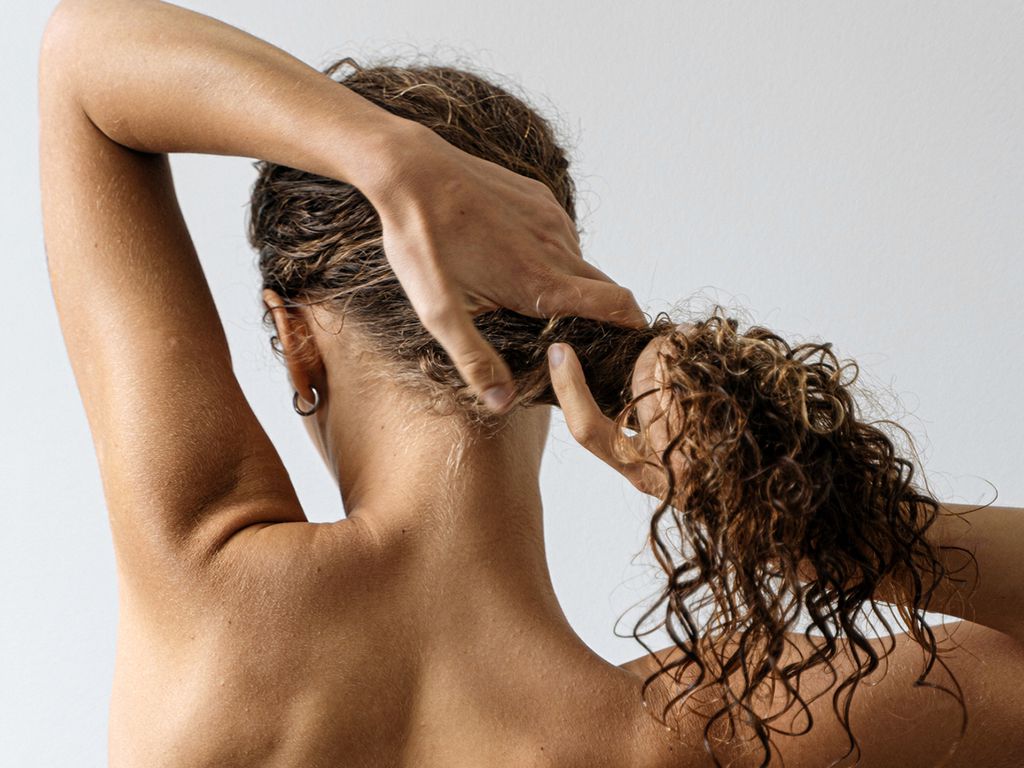Has your hair seemed limper than normal? Or perhaps it feels like it gets greasy way too soon after a shower? Whatever the case may be, the sequence of your in-shower haircare products could be to blame. With that in mind, we’re here to talk about the benefits of reverse washing hair. Keep reading for two dermatologists’ takes on the trendy hair-washing regimen that’s popping up all over social media.
Meet the Expert
- Craig Ziering, DO, is a board-certified dermatologist, hair transplantation surgeon, and restoration specialist.
- Purvisha Patel, MD, is a board-certified dermatologist, MOHS and cosmetic surgeon, and the founder/owner of Advanced Dermatology and Skin Cancer Associates.
What Is a Reverse Wash?
From the name alone, you might be able to guess. But, if not, board-certified dermatologist Craig Ziering, DO, confirms that reverse washing is exactly what it seems. “It is implementing a reversed order of products by first conditioning hair (usually a deeper conditioning), and then following up with the cleanser or traditional shampoo,” he says.
But why?
“The theory is based on the idea that conditioner left on first will infuse the nutrients for soft, hydrated hair strands while the porosity of the keratin protein is open from the pH of our water,” he explains, noting that clean and clear follicles are most receptive to the nourishing hydration of conditioner. “Conditioners are an important part of any haircare routine, as they nourish and hydrate the hair itself and lock in needed moisture for healthy, shiny, elastic hair.”
What’s more, since hair cuticles are more likely to absorb the conditioner’s hydration when it’s used first, Ziering points out that reverse washing is often looked at as an aesthetic measure for those with fine and thin hair. “Of course this is a purely cosmetic effect, and while it may help some patients’ hair look thicker, it will not in any way treat the cause of your thinning or hair loss,” he says.
Who Should Do a Reverse Wash?
Considering that the top benefits of reverse washing include deeply hydrating the hair and potentially making it swell to appear fuller, board-certified dermatologist Purvisha Patel says that those with very fine hair, as well as as those with flat, oily strands, can benefit from switching the order.
“Conditioner is lipophilic, as it coats the scalp and hairs,” she explains. “So it is left to condition, then washed off instead of [simply rinsing it off]. This can help with a greasy scalp and keep fine, limp hair from getting weighed down with conditioner.”
Ziering says that more natural hair types (like ethnic or AA hair) can also benefit, thanks to the deeply hydrating nature of reverse washing.
Lastly, Ziering says that those with thinning hair can also benefit from reverse washing. “Those who are losing their hair or seeing hair thinning and do not want to leave any ‘heaviness’ of product on their hair or have their hair appear flat may use this as a way to mask the appearance of finer or thin hair,” he says. “This patient population uses conditioner to nourish first and cleansing to clarify, eliminating any of the residue some conditioners may leave behind on the hair.”
The Pros
The biggest benefit of reverse washing, according to Patel, is that you get the conditioning of the hair shaft without the layer of conditioner left on the scalp. Additionally, because reverse washing follows up conditioner with shampoo, she says that any conditioner residue that could potentially lead to bacne will also be rinsed off.
From Ziering’s perspective, the pros of reverse washing come down to hydration and volume.
“Overall it will help with the health and hydration, as well as reparation of the hair before the cleaning step,” he says. “The diameter of the hair will [also] swell and it will feel and appear larger per strand. Therefore, the hair may appear more dense—including at the roots, which may appear lifted and not as flat.” In that way, Ziering reiterates that reverse washing can help mask thinning.
One other benefit, according to Ziering, is that your hair may look cleaner for longer, because conditioner, only when rinsed off (as opposed to washed off with shampoo), may cause greasier hair sooner than with a reverse wash.
The Cons
While reverse washing can be beneficial for some natural hair types, Ziering and Patel agree that those with coarse or tightly coiled hair may not see the same results.
Additionally, while reverse washing can mimic the appearance of fuller hair, Ziering points out that, even with high-quality products, this method is no replacement for professional hair loss treatments. “For real increases in density or to mitigate losses, it is imperative to intervene early and visit a specialist for an expert diagnosis and a treatment plan to manage the condition,” he says.
How to Perform a Reverse Wash
A reverse wash is simple. Rather than starting with shampoo, Ziering says to begin with conditioner after wetting your hair.
“Apply the conditioner from the scalp to the ends of hair, massaging thoroughly or combing through for up to five minutes,” he says. “Concentrate on the bottom two-thirds, where the hair receives the least amount of natural sebum.”
Once those five minutes are up, rinse hair with warm water and wash with a small amount of shampoo (think: between a quarter- and half-dollar-sized dollop). Rinse, et voilà. That’s all there is to it.
How Often Should You Reverse Wash?
If you find reverse washing to be beneficial for your hair type, Patel says that you can use the method every time you wash your hair. Simple as that.
The Final Takeaway
Reverse washing can be beneficial for those with dry, fine, and/or flat hair. If you have incredibly curly or coarse hair, however, shampooing away the conditioner may take away too much of the necessary moisture that conditioner can impart. That said, Ziering recommends applying a final coat of conditioner between the shampoo and final rinse, to coat strands with a final dose of hydration. Though, if that doesn’t deliver enough moisture for your curly locks, reverse washing might not be for you. To find out which hair-washing regimen is right for your hair, consider chatting with your hairstylist or dermatologist, both of whom should have tips on maintaining hair and scalp hydration.
How to Shampoo Your Hair the Right Way for Gorgeous Results










